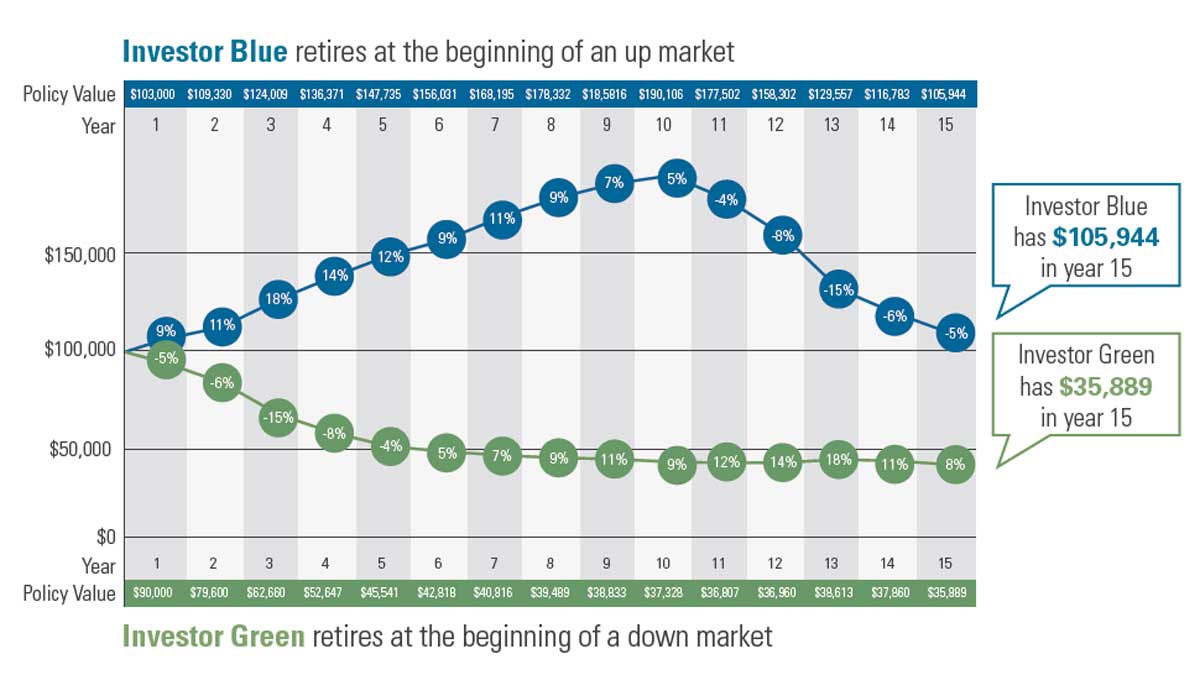One Way Near-Retirees Can Ride Out a Recession
There's no reason to freak out about a recession, but stakes are different for those in the "fragile" decade. If you're worried, here's how to insure your retirement income against a bear market.


Though the energy and anxiety we spend on them might suggest something more epic and frightening, recessions are simply a normal part of the economic cycle. Some are worse than others.
Certainly, those of us who lived through the Great Recession may be predisposed to some outsized worry. But recessions are healthy and necessary.
Recessions Have Some Good Points
Like the seasons, economic cycles include periods of growth and periods of depletion and rest. We shed unhealthy waste in the fall and winter of our economic cycles to make room for the green shoots and progress of cycles that follow.
From just $107.88 $24.99 for Kiplinger Personal Finance
Become a smarter, better informed investor. Subscribe from just $107.88 $24.99, plus get up to 4 Special Issues

Sign up for Kiplinger’s Free Newsletters
Profit and prosper with the best of expert advice on investing, taxes, retirement, personal finance and more - straight to your e-mail.
Profit and prosper with the best of expert advice - straight to your e-mail.
Failing companies that struggle to make it through periods of growth finally shutter, and their employees are released back into the pool of worker talent to feed healthy future growth. Equities prices are "pruned" back, and other so-called "creative destruction" allows for new growth and innovation.
Right now, stocks are approaching historically expensive valuations, for example. A recession will make future investments cheaper, which is good in the long run. In the short term, though, the story can be a bit different. Unemployment, declining asset values and general uncertainty present different challenges for workers based on their age and how close they are to retiring.
On the investments side, for example, younger savers are more likely to be able to make up portfolio losses over their long(er) investment horizons. For a 60-something worker, the stakes are much higher.
The Fragile Decade
Weathering a recession while drawing down an asset can have a lasting negative impact on retirement income. That's why we refer to the last five working years and first five years of retirement as the "fragile decade." Unlike younger workers, folks living through their fragile decade don’t have the time to make up for losses during a downturn and may want to consider defensive positions to protect themselves from big losses.
Low-cost, next-generation annuities developed over the last few years are designed to protect investors and help usher them through the fragile decade without the onerous lock-up periods, and rigid limitations of traditional variable annuities.
Sequence of Returns Risk – the First Hurdle in Retirement
A recession early in retirement can drag your assets down as you begin simultaneously taking income. This double dip puts you at risk of outliving your assets. The impact of that same recession wouldn't be nearly as catastrophic if it happened in year 11 rather than year one of retirement.
In fact, our research has shown that if an investor's sequence of returns were inverted — from retiring during a recession, to retiring during an up market — outcomes would be markedly different. In the chart below, we look at two 15-year periods of identical returns. In the first, Investor Green retires during a five-year recession followed by a 10-year bull market. In the second, we reversed the order. Investor Blue retires during a 10-year period of growth followed by a five-year recession. These are identical annual performance numbers — though sequenced in reverse — with very different results.
That's because Investor Blue enjoys 10 years of positive returns while beginning to take income rather than the inverse. Those positive returns would offset the withdrawals, and potentially grow the asset before the negative returns begin to affect the investment.

Source: RetireOne, "Sequence of Returns Risk." Please note that the simple hypothetical illustration above does not represent the results of an actual investment. It does not reflect any investment fees, expenses or taxes associated with investments. An average annual return of 4% is reflected for both investors. Annual withdrawals of $5,000 are taken at the end of each year.
The risk in the timing of poor portfolio performance and retirement income withdrawals is called "sequence of returns risk." That risk is what makes your last five working years and first five years in retirement so fragile. As such, sequence of returns risk is the first major hurdle to clear in retirement.
How to 'Insure' Your Future Income
Planning how to convert an asset into an income stream in retirement should begin at least 10 years before you begin to draw down your assets, and it could include looking into ways to "insure" your income stream against downturns. This may be especially important now, since we're in year 11 of an unprecedented bull market run that some believe may be coming to an end.
You may "insure" your future retirement income during this fragile decade by taking a portion of your assets and purchasing a variable annuity with a guaranteed lifetime withdrawal benefit ("GLWB"). The key is to invest in a low-cost, commission-free variable annuity with no surrender charges.
In this case, a variable annuity with GLWB is preferable to a single premium immediate annuity because it provides strong, guaranteed income with market participation and the ability to cancel and walk away at any time. The ability to cancel is really important because you don't want to be stuck paying for protections you no longer need.
If you buy a low-cost variable annuity with a GLWB, you may expect to pay something like 1.5% to 2% in annual fees (insurance expenses, underlying investment expenses and rider charges). This is insurance. It costs money. Once you make it to the other side of the fragile decade you may then decide to keep the GLWB rider or get rid of it and reduce your expenses. More on that in a bit.
During the deferral period — in this case the first five years, before you begin taking income — some variable annuity GLWB riders offer an annual "roll-up" that guarantees the benefit base will increase annually by a prescribed percentage regardless of what happens in the market, and ultimately to your investment.
This is the insurance component, but bear in mind that the benefit base is NOT your account value. Your account may actually lose money, and your benefit base may steadily increase. The beauty of this tactic is that the benefit base is the dollar amount upon which the insurance company bases your income payments.
Let's say that guaranteed roll up amount is 7.2% annually. After five years your benefit base would grow regardless of what happens in the market. In this example, investing $500,000 in the annuity could generate income payments based on a $708,000 benefit base (as long as you don't withdraw any money in that time).
Canceling the GLWB and/or the Variable Annuity
If your annuity performs better than 7.2% annually, then your account value equals or exceeds your benefit base, and you'll be faced with a decision about whether you even need the GLWB anymore.
Insuring the fragile decade with a variable annuity GLWB has other benefits. If you purchase the annuity contract in an IRA, you may cancel the whole annuity contract without any tax consequences and eliminate all of the expenses of the variable annuity.
It's like buying an insurance policy for your IRA assets, then canceling when you no longer need the insurance. There are no additional tax benefits associated with investing IRA assets in a variable annuity, however.
Keep in mind that if you decide to remove the GLWB rider, you'll probably have a 30-day window on one of the contract anniversaries to cancel (maybe every fifth year), and you will lose your benefit base. Your financial adviser can give you the proper guidance.
Waiting Five More Years (A Decade of Deferral)
If you can afford to wait another five years before taking income, you may have the opportunity to further improve your footing for retirement. Remember the Rule of 72? It’s a quick way of determining how long it will take for an investment to double. Divide 72 by 7.2. It would take 10 years for an investment earning a 7.2% annual rate of return to double. After 10 years your benefit base could grow to twice its original value, again, regardless of what happens in the market. In this case $500,000 could grow to a benefit base of $1 million — again, provided you don't take any withdrawals in that period.
Using a variable annuity with a GLWB can help you bridge this fragile decade, which would allow you to increase your "risk budget" and take on some additional risk in other parts of your portfolio, if necessary. If markets do well, you'll do well. If not, you will have insured yourself against an income shortfall (and longevity risk) by growing your benefit base in the GLWB rider.
When your fragile decade is in the rearview mirror, there'll be other risks to address, but, at the very least, you will have hurdled the first major obstacle to overcoming longevity risk, and that's sequence of returns risk.
Regardless of what experts think about how soon a recession may come or how bad it may be, it is no reason to panic. Some folks are simply more vulnerable than others, and should speak with their financial adviser about planning accordingly. Waiting too long to have that conversation can have lasting consequences.
Profit and prosper with the best of Kiplinger's advice on investing, taxes, retirement, personal finance and much more. Delivered daily. Enter your email in the box and click Sign Me Up.

David Stone is founder and CEO of RetireOne™, the leading, independent platform for fee-based insurance solutions. Prior to RetireOne, David was chief legal counsel for all of Charles Schwab's insurance and risk management initiatives. He is a frequent speaker at industry conferences as well as an active participant on numerous committees dedicated to retirement income product solutions.
-
 Small Caps Can Only Lead Stocks So High: Stock Market Today
Small Caps Can Only Lead Stocks So High: Stock Market TodayThe main U.S. equity indexes were down for the week, but small-cap stocks look as healthy as they ever have.
-
 Ask the Editor: Tips for Filing Your 1040
Ask the Editor: Tips for Filing Your 1040Ask the Editor In this week's Ask the Editor Q&A, Joy Taylor answers questions on preparing and filing your 2025 Form 1040.
-
 Is Direct Primary Care Right for Your Health Needs?
Is Direct Primary Care Right for Your Health Needs?With the direct primary care model, you pay a membership fee for more personalized medical services.
-
 If You're in the 2% Club and Have a Pension, the 60/40 Portfolio Could Hold You Back
If You're in the 2% Club and Have a Pension, the 60/40 Portfolio Could Hold You BackIncome from your pension, savings and Social Security could provide the protection bonds usually offer, freeing you up for a more growth-oriented allocation.
-
 Bye-Bye, Snowbirds: Wealthy Americans Are Relocating Permanently for Retirement — and This Financial Adviser Can't Fault Their Logic
Bye-Bye, Snowbirds: Wealthy Americans Are Relocating Permanently for Retirement — and This Financial Adviser Can't Fault Their LogicWhy head south for the winter and pay for two properties when you can have a better lifestyle year-round in a less expensive state?
-
 Consider These 4 Tweaks to Your 2026 Financial Plan, Courtesy of a Financial Planner
Consider These 4 Tweaks to Your 2026 Financial Plan, Courtesy of a Financial PlannerThere's never a bad time to make or review a financial plan. But recent changes to the financial landscape might make it especially important to do so now.
-
 We Know You Hate Your Insurance, But Here's Why You Should Show It Some Love
We Know You Hate Your Insurance, But Here's Why You Should Show It Some LoveSure, it's pricey, the policies are confusing, and the claims process is slow, but insurance is essentially the friend who shows up during life's worst moments.
-
 Is a Caregiving Strategy — for Yourself and Others — Missing From Your Retirement Plan?
Is a Caregiving Strategy — for Yourself and Others — Missing From Your Retirement Plan?Millions of people over 65 care for grandkids, adult kids or aging parents and will also need care themselves. Building a caregiving strategy is crucial.
-
 6 Financially Savvy Power Moves for Women in 2026 (Prepare to Be in Charge!)
6 Financially Savvy Power Moves for Women in 2026 (Prepare to Be in Charge!)Don't let the day-to-day get in the way of long-term financial planning. Here's how to get organized — including a reminder to dream big about your future.
-
 Private Equity Is Fundamentally Changing: What Now for Investors and Business Owners?
Private Equity Is Fundamentally Changing: What Now for Investors and Business Owners?For 40 years, private equity enjoyed extraordinary returns thanks to falling rates and abundant credit. That's changed. What should PE firms and clients do now?
-
 I'm a Real Estate Expert: 2026 Marks a Seismic Shift in Tax Rules, and Investors Could Reap Millions in Rewards
I'm a Real Estate Expert: 2026 Marks a Seismic Shift in Tax Rules, and Investors Could Reap Millions in RewardsThree major tax strategies will align in 2026, creating unique opportunities for real estate investors to significantly grow their wealth. Here's how it works.